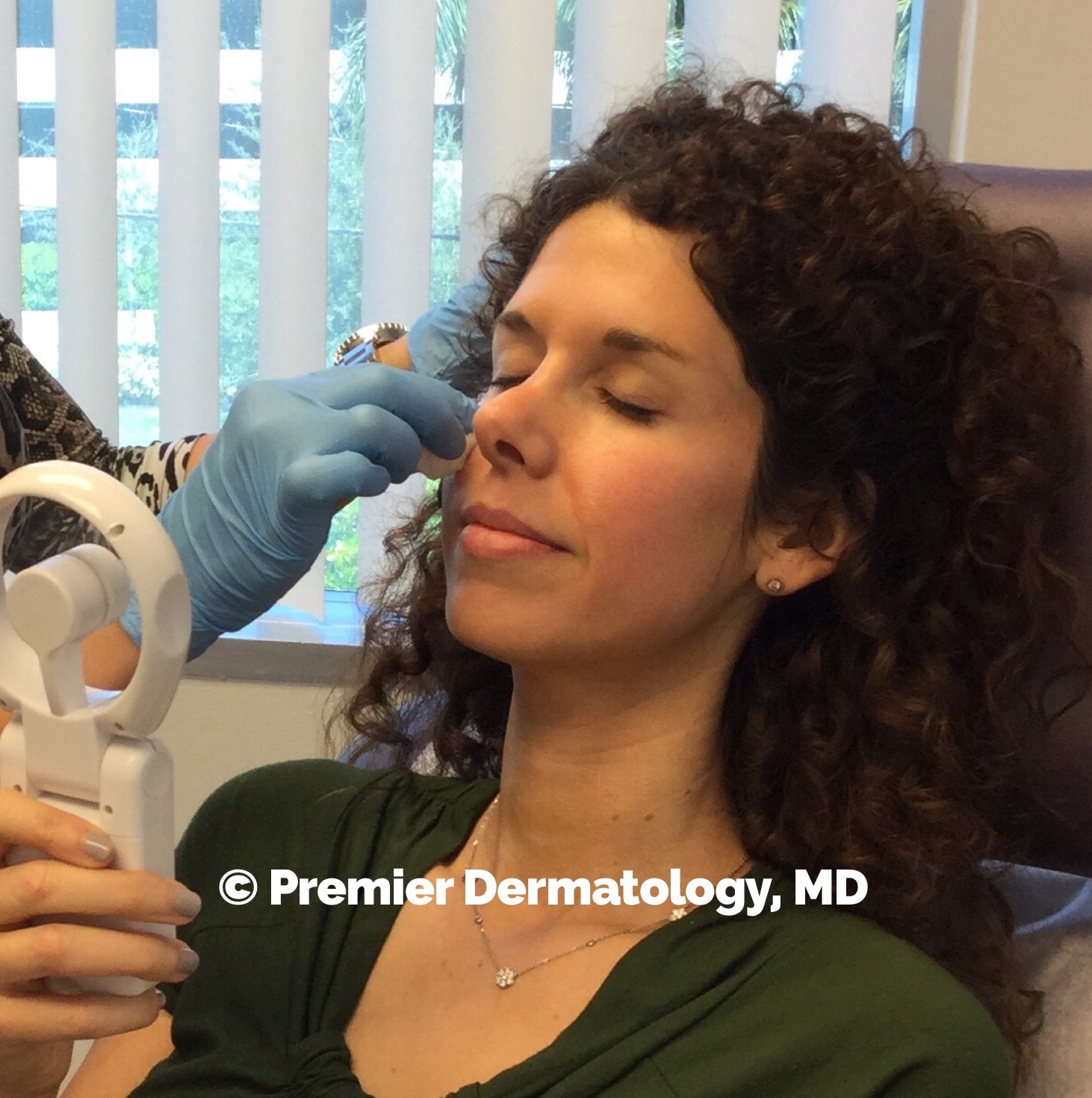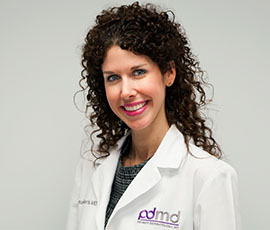How a-peeling!
What can brighten dark spots, improve acne, even out skin tone, and treat mild photoaging, but with minimal downtime? Chemical peels!
What kind of peels are available at Premier Dermatology, MD? We offer glycolic acid peels, salicylic acid peels, the Miami Peel, and the Vi peel.
Glycolic acid peels: Contains glycolic acid: an AHA, alpha-hydroxy acid, which is a naturally occurring compound made from sugar. The depth or strength of the peel depends on which concentration is used. 20-50% glycolic acid is a very superficial peel, while 50-70% is a little stronger (deeper), but still considered a superficial peel. Superficial peels affect the very top layers of the skin. There is generally little to no physical peeling with these treatment. These peels are done monthly.
Salicylic acid peels: Contains salicylic acid: a BHA, beta-hydroxy acid. This is a great peel for acne, clogged pores, and oily skin types. These peels are superficial and may result in mild peeling, but overall there is minimal downtime. These peels are done monthly.
Miami peel: Contains hydroquinone, lactic acid, salicylic acid, citric acid, and kojic acid. This peel is good for all skin types, but works especially well for hyperpigmentation and melasma. There is no peeling with this peel, and it can be performed every two weeks for best results.
Vi peel: Contains trichloroacetic acid (TCA), phenol, retinoic acid, and vitamin C. This peel is great for hyperpigmentation, melasma, fine lines, sun damage, improves skin tone and texture. It is safe for all skin types. Skin will peel for 3-5 days following the peel. It can be done monthly. And then? Radiant, healthier looking skin!
Call 305-521-8971 to schedule a complimentary consultation with Dr. Bilu Martin and see which peel is right for you!

Dr. Billu Martin practices what she preaches: getting her Vi peel!
Itchy and Scratchy
October is Eczema Awareness month. So what is eczema?
At Premier Dermatology, MD, Dr. Bilu Martin sees and treats eczema regularly in babies, kids, teens, and adults. It can be very itchy and is often annoying to patients. In Greek eczema means "to boil over," which refers to the blistering or weepy phase of the disease. Eczema can start in infancy as crusted patches on the scalp, cheeks, bottoms, arms, and legs. Later, as kids get older, it often shows up on the inside of arms and backs of knees. Adults usually develop hand and finger dryness and cracking, which is often painful.
Although there is no known exact cause, it seems to run in families and has a genetic link. The immune system may be more sensitive to certain triggers. Often, asthma and seasonal allergies run together with eczema. People that have two of three of this conditions are called "atopics." They have skin that is easily irritated.
People with eczema are very sensitive to fragrances and chemicals. All soaps, detergents, and moisturizers should be mild and fragrance free. Some good options are dove, cetaphil, cerave, eucerin, and vanicream. Make sure baths and showers are lukewarm, not hot. MOISTURIZING is a must. Moisturize right after coming out of the bath, when skin is still damp. A great choice is aquaphor. It's great for any skin area, as a lip moisturizer, for laser and peel after-care, for wound healing, on areas after biopsies and surgeries, etc. Slather it on. If it seems too greasy to use during the day, put it on at night and sleep with it. For dry, cracked hands, slap on aquaphor and then cotton gloves on top. Avoid soaking hands in water; use gloves when doing the dishes or housework. And certain fabrics, like wool, can be very irritating to atopic skin.
When moisturizing is just not enough, there are prescription steroid and non-steroid creams for the skin, as well as antihistamines that can be recommended by a doctor. Also: raw, scratched areas can easily become superinfected with bacteria and viruses, so it's important to see a dermatologist regularly. Although many kids will outgrow eczema, there are still plenty of adults affected by it. Lucky for us Floridians - summer months are usually better for atopic skin than cold, dry winters.
Are you tired...?
Finally, with any skin condition, taking care of your overall health is essential. Sleeping a full eight hours, eating a healthy diet rich in antioxidants (green tea, vitamin C, vitamin E, resveratrol, acai, blackberry, etc), exercise, and stress relieving activities (yoga, breathing) are vital to a youthful, energized, beautiful, you!
Beautiful Girls
Halle Berry. Michelle Pfeifer. Megan Fox. Chances are, when you hear these names, you think of the word beauty. But what makes us label these women as beautiful? Many people will say that symmetry is what makes people look beautiful. To a certain extent, this is true. Our eye is automatically drawn to what is abnormal, or "stands out" on someone's face. An imperfection or asymmetry on one side of the face is often considered less appealing. Think of Austin Powers, where Mike Myers can't stop focusing on the "moley moley moley mole." Or when you have a large pimple on your face and you feel like everyone in the world is staring right at it. But symmetry is not the whole answer. If you cut a photo of someone's face in half and superimpose one half on the other, you'll see that even the most "beautiful" people's faces are not perfectly symmetric. Conversely, if you computer generate a person with both sides of their face in perfect symmetry, they actually just look...wierd.
Often we consider certain features to be more attractive. High cheekbones, wide eyes, full lips, white, even teeth. But what about people whose features don't conform to that? Think of Lauren Hutton's gap in her top teeth, or Angelina Jolie's large lips, or Brooke Shield's thick, heavy eyebrows. All considered beautiful women.
So what else? Proportion plays a large role in shaping our perception of beauty. Dr. Stephen Marquardt talks about the "Golden Ratio," a certain proportion found in nature (1.618:1) that describes the proportions seen in the ideal, or beautiful face. He says that this ratio is constant in beautiful faces, regardless of culture, race, or era. The distance between the eyes, between the nose and the upper lip, and the size of the upper lip to the lower lip have all been measured and described as what is the "ideal" distance.
I personally think that the concept of beauty is too complicated to explain with a single number, or a single answer. I think it's a combination of facial symmetry, facial volume, proportion of features, shape of individual features, clarity and texture of skin and hair, brights of the eyes, etc. And one important feature that can't be changed with botox, fillers, lasers, or peels: personality!
What's an AK?
On Premier Dermatology, MD's facebook page, (like us!) Dr. Bilu Martin posted a photo of herself to show a spot on her cheek that she treated. The spot is an actinic keratosis (AK), and they are quite commonly seen, especially in South Florida. Aks debut as rough, scaly patches that are usually red, pink, or brownish. They feel like sandpaper. They can develop anywhere but are often found on the scalp (in men), cheeks, nose, lips, ears, backs of the hands, and chest. Often, there are multiple Aks, in which case they are called actinic keratoses.
These spots are PRE-cancerous. They are caused by exposure to the sun. A very low percentage of actinic keratoses, around 10%, may develop into a type of skin cancer called squamous cell carcinoma (SCC). Squamous cell carcinomas can be removed in the dermatologist's office surgically.
There are a variety of treatments for actinic keratoses. They can be frozen with liquid nitrogen, either with a spray or a cotton-tipped applicator. This will result in a red, crusty spot for a few days and then will resolve. There are also topical medications, such as 5-fluorouracil, imiquimod, diclofenac, and ingenol mebutate that a dermatologist can prescribe. These are applied to the Aks for a few weeks to months, depending on which cream is used. They will almost often cause redness, crusting, and irritation to the area in which they are applied, which then goes away. Sometimes a combination of freezing and creams are used. Photodynamic therapy (PDT) is an in-office treatment that is also quite effective to treat AKs.
The best way to prevent the formation of actinic keratoses and skin cancer is to protect your skin from the sun. Use a broad-spectrum sunblock. Seek the shade. Wear sun protective clothing. And remember to have regular skin examinations. Early detection and prevention is key!
Categories
- November 2014 (1)
- December 2014 (3)
- January 2015 (4)
- February 2015 (3)
- March 2015 (1)
- April 2015 (3)
- May 2015 (4)
- June 2015 (2)
- July 2015 (0)
- August 2015 (1)
- September 2015 (2)
- October 2015 (4)
- November 2015 (1)
- December 2015 (1)
- January 2016 (2)
- February 2016 (1)
- March 2016 (3)
- April 2016 (2)
- May 2016 (1)
- June 2016 (1)
- August 2016 (1)
- October 2016 (1)
- January 2017 (1)
- February 2017 (1)
- June 2017 (1)
- August 2017 (1)
- October 2017 (1)
- December 2017 (1)
- April 2018 (1)
- May 2018 (1)
- November 2018 (1)
- May 2019 (1)
- July 2019 (1)
- January 2020 (1)
- March 2020 (2)
- July 2020 (1)
- November 2020 (0)
- January 2021 (1)
- October 2021 (1)
- January 2022 (1)
- June 2022 (1)
- November 2022 (1)
- April 2023 (1)
- September 2023 (1)
- September 2023 (1)
- December 2023 (1)
- February 2024 (1)
- July 2024 (1)
- September 2024 (1)
- March 2025 (1)
- October 2025 (1)
Archives
Latest on blog
The fountain of youth: collagen!
Published September 30th, 2025These days, everyone is searching for the elusive Fountain of Youth. But dermatologists know what...
Learn More
